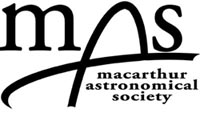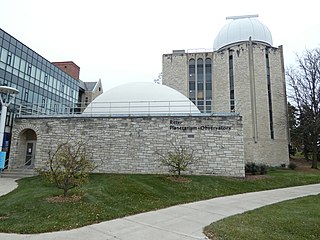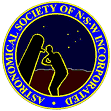
The Adler Planetarium is a public museum dedicated to the study of astronomy and astrophysics. It was founded in 1930 by Chicago business leader Max Adler. It is located on the northeast tip of Northerly Island at the shore of Lake Michigan in Chicago, Illinois. The Adler was the first planetarium in the United States and is part of Chicago's Museum Campus, which includes the John G. Shedd Aquarium and The Field Museum. The Adler's mission is to inspire exploration and understanding of the universe.

The Kopernik Observatory & Science Center (KOSC), is a public observatory in Vestal, New York opened to the public on 16 June 1974 by the Kopernik Society of Broome County to commemorate the 500th anniversary of the birth of the astronomer Nicolaus Copernicus in 1973. Its mission is to offer hands-on investigations and outreach programs for educating all ages about astronomy and science using advanced optical telescopes, computers and other tools. It is the first science laboratory facility in New York State designed for K-12 teachers, students and their families, and has been one of the best-sited and best equipped public observatories in the Northeast United States for nearly the last 40 years.
The Amateur Astronomers Association of Pittsburgh (AAAP) was founded on June 9, 1929, by Chester B. Roe and Leo J. Scanlon. Since then, it has grown to over 500 members and operates two observatories in the Pittsburgh region: the Nicholas E. Wagman Observatory and the Mingo Creek Park Observatory. The club also sponsors many star parties that are open to members of the public throughout the year.

Ralph A. Worley Observatory is an astronomical observatory currently under lease to Shreveport-Bossier Astronomical Society. It was built in 1964 by the Shreveport-Bossier Astronomical Society and later donated to the Caddo Parish School System. It is located 8 miles south of Shreveport, Louisiana, USA.

Rainwater Observatory and Planetarium is an educational astronomical observatory and Planetarium run as an educational ministry of French Camp Academy. It is located near French Camp, Mississippi, United States. It is the largest observatory in Mississippi with 16+ telescopes, with the largest instruments including a 32-inch Dobsonian telescope and 14-inch Celestron catadioptric telescope. Rainwater is currently awaiting delivery of the Sollee Telescope, a 25-inch research-grade telescope. When installed in the two-story observatory building already constructed in the observatory complex, the Sollee Telescope will be suitable for serious astronomical studies, in the last remaining "dark spot" in Mississippi on the U.S. Dark Skies photograph.

The Society for Popular Astronomy (SPA) is a national astronomical society based in the United Kingdom for beginners to amateur astronomy.
The Royal Astronomical Society of Canada (RASC) is a national, non-profit, charitable organization devoted to the advancement of astronomy and related sciences. At present, there are 28 local branches of the Society, called Centres, in towns and cities across the country from St. John's, Newfoundland, to Victoria, British Columbia, and as far north as Whitehorse, Yukon. There are about 5100 members from coast to coast to coast, and internationally. The membership is composed primarily of amateur astronomers and also includes numerous professional astronomers and astronomy educators. The RASC is the Canadian equivalent of the British Astronomical Association.

The International Year of Astronomy (IYA2009) was a year-long celebration of astronomy that took place in 2009 to coincide with the 400th anniversary of the first recorded astronomical observations with a telescope by Galileo Galilei and the publication of Johannes Kepler's Astronomia nova in the 17th century. The Year was declared by the 62nd General Assembly of the United Nations. A global scheme, laid out by the International Astronomical Union (IAU), was also endorsed by UNESCO, the UN body responsible for educational, scientific, and cultural matters.
The Birmingham Astronomical Society was founded in 1977 in Birmingham, Alabama (USA), by amateur astronomers. Monthly meetings are held at 7:00 p.m. at the Samford University Planetarium on the third Tuesday of each month. Monthly observing sessions, are held at dark sky site called Chandler Mountain or at Oak Mountain State Park just south of Birmingham. There is also a Birmingham Astronomical Society based in the UK, which meets in the basement of Aston University, near Birmingham (UK) city centre every Wednesday evening at 7:30 p.m.
Anton Vamplew, is an English amateur astronomer, author, lecturer and media presenter of the subject.
The Escambia Amateur Astronomers Association (EAAA) is an amateur astronomy club in Northwest Florida.
Mansfield and Sutton Astronomical Society (MSAS) is an amateur astronomical society in the East Midlands of England. It was formed in 1969. It is based at Sherwood Observatory, a 61 cm mirror telescope which it owns and operates. The observatory lies 4 km south west of the centre of Mansfield on one of the highest points in the county of Nottinghamshire.

J A Jones Hoober Observatory is a privately owned observatory located in South Yorkshire, England near to the villages of Hoober and Wentworth, 4 miles (6.4 km) North-northwest of Rotherham. It can be found about 300 metres (0.19 mi) east of Hoober Stand. The observatory is owned and operated by Mexborough & Swinton Astronomical Society (NPO).
The Astronomical Society of South Australia (ASSA) was founded in 1892 and is the oldest society of its kind in Australia. It is the only representative body for amateur astronomy in the state of South Australia. It holds regular general monthly meetings, frequent meetings for members of specialised groups and has available two observatories, one with a 300mm telescope at The Heights School within easy reach of Adelaide and used primarily for public viewing, and a second at Stockport with 500mm and 450mm telescopes presently in service and a larger 36-inch instrument currently being considered.
On May 31, 1989, seven amateur astronomers held an organizational meeting in the Solar Classroom at Hamilton College in Clinton, New York, to plan the formation of an astronomy club. By-laws were prepared by Richard Somer, approved by the group, and the Mohawk Valley Astronomical Society was born. The founders were Richard Somer, Arlene Somer, Joe Perry, Sam Falvo, Dan Pavese, John Ossowski, and Phil Marasco.

Macarthur Astronomical Society is an organisation of amateur astronomers, based in the Macarthur Region of outer South Western Sydney, NSW, Australia, including the local government areas of the City of Campbelltown, Camden Council, Wollondilly Shire, the City of Liverpool and surrounding districts.

The Ritter Observatory is an astronomical observatory owned and operated by the University of Toledo (UT) in Toledo, Ohio (USA). The Ritter Planetarium is located in the same building, and the university also operates Brooks Observatory in an adjacent building. Ritter Observatory features a 1.06 m (42 in) Ritchey-Chrétien telescope built in 1967 by Warner & Swasey Company of Cleveland, Ohio. It was installed in 1968, and is used primarily for spectroscopy and occasionally for instruction and public viewing events. Research conducted at the observatory focuses on long-term spectroscopic monitoring of stars such as Rigel, Beta Lyrae, and Zeta Tauri.

The Astronomical Society of Glasgow (ASG) was founded in 1954 in Glasgow, Scotland, by amateur astronomers and is dedicated to promoting an interest in Astronomy.

The Astronomical Society of New South Wales (ASNSW) is an amateur astronomy club in the state of New South Wales, Australia. It was founded in 1954 and it has over 400 members.

The Astronomical Society of Victoria (ASV) is an amateur astronomy club in the state of Victoria, Australia. It was founded in 1922, making it one of the oldest such clubs in the country, and with some 1000 members it claims to be one of the largest amateur astronomy organisations in the southern hemisphere. Membership is open to all with an interest in astronomy, and the society caters for people with a wide range of ages, backgrounds, abilities and interests.











